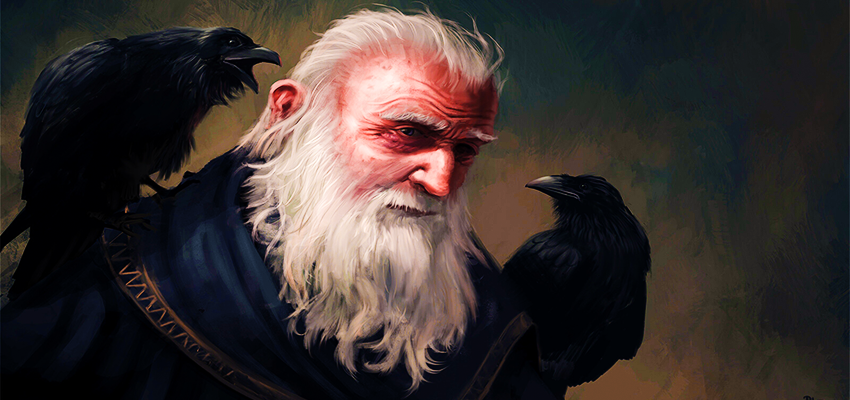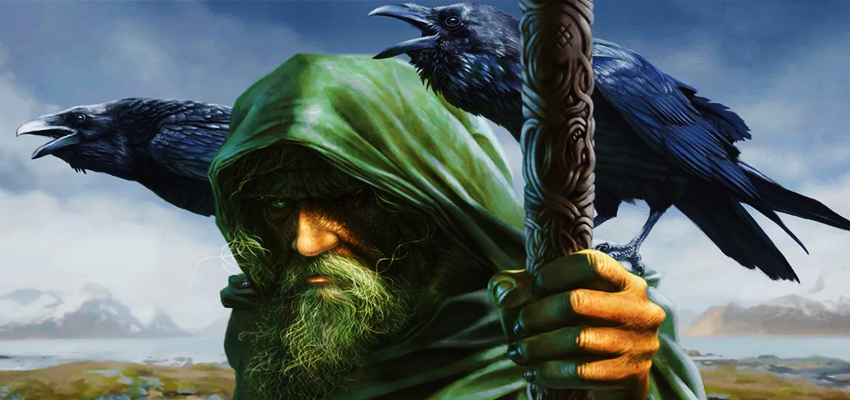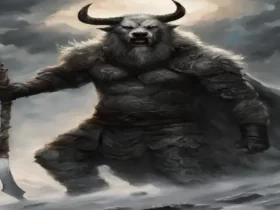The most important figure at any time, Odin, is always attended by two ravens. They assist him in carrying out his duties and keep a watchful eye on the world around him. Whether Odin is presiding over a mighty regale or spanking into the battle of Ragnarök, where he must meet his destruction, he always has the wise ravens “Huginn and Muninn” with him. What makes Odin’s ravens so unique is that they are not only servants of Odin, they are more than that and they also possess incredible powers. They’ve proven themselves over and over again as allies that never quit and friends that stick together through thick and thin.
1Huginn And Muninn Are Servants & Messengers Of Odin

Huginn and Muninn are two ravens that exist in Norse mythology. According to Norse Mythology they are said to be the servants of Odin, who are constantly on the lookout for information. They’re also described as Odin’s messengers, who take messages back and forth to him. The birds set forth every early morning to fly around the Norse world, Midgard. At dinner time, they come back to their roost on his shoulders and share information with him about what they’ve seen during their day, so he’ll know what’s going on in the world.
2 They May Look Like Ordinary Ravens But Have Extraordinary Abilities

Huginn and Muninn are nothing much special in the physical sense except physically speaking ability; it means they have a lot in common with your average garden raven. They’re big and scary looking, with inky black feathers and a very sharp and pointed pecker. The wings of these birds are powerful enough to fly them exalted into the sky, while their beady eyes enable them to make out distant objects clearly in the landscape below.
People often mistakenly think that Huginn and Muninn are ordinary ravens. In truth, they might look similar to regular ravens but the unprecedented powers bestowed upon them by Odin make them quite extraordinary.
3They Can Fly To Cover Entire Midgard In A Single Day
Firstly, the birds are able to travel pretty extensively across the whole world of Midgard in just only one day.
4These Odin’s Ravens Can Speak & Communicate With Humans With Their Native Language
Second, Huginn and Muninn have the unique ability to understand men in their native language, even they also can speak. This ability makes them an invaluable part for Odin who rely on their understanding and insight (Odin).
5They Have Great Analytical Senses & Sharp Mind Which Is Much Better Than An Ordinary Raven
Third, they have highly efficient minds and keen powers of observation, even an ability to think critically about everything. There is more to the ravens than just following Odin’s orders means they are not only just mere spies.
6Huginn And Muninn Leak Opponent’s Secrets To Odin As His Ideal Spies
These creatures have a significant role of importance and a close relationship with the god Odin, too, In the other words, ravens are also important advisors and trusted companions to Odin. Huginn and Muninn can also go with Odin in the battle, as well as helping him to conduct and remedy his horse. The supernatural ravens also provide valuable information about the enemy’s activities during battle.
7 Huginn Reprents “Thought” And Muninn Symbolize “Mind or Desire”

There are varying opinions on what Huginn and Muninn represent. Some scholars believe that they’re representations of Odin himself, and not just common ravens who are bestowed with exclusive powers. Norse culture had a unique belief in the power of dreams, it was generic for shamans to pierce a trance-like state; during that time they send their thoughts and consciousnesses into the world to experience and collect information.
The names of Odin’s ravens – Huginn means “thought” and Muninn means “mind or desire” – were believed to represent his two aspects of conscious self. Odin is considered the leader of all the gods, but some have speculated that he could project his “thought” and his “mind” with the same type of effectiveness a shaman would be able to. The ravens are just elemental representations of his omnipotence.
8Some Norse Theories Suggests These Raven’s Are Actually Odin’s Fylgjur
Other scholars believe that the older of Odin’s two ravens, Huginn, and his more intelligent younger counterpart, Muninn, are Odin’s “fylgjur”. In Norse culture, spirit animals known as “fylgjur” are Generally seen accompanying noble men and women. These animals are expressions of the person’s character. For instance, somebody with a fox as a fylgja which signifies cunning and craftiness, whereas somebody with an ox as a flygja would indicate strong but tame.
Different cultures across the world have different myths, but Norse culture seems to have some of the fiercest and most awe-inspiring of them all. In this particular case, the raven’s association with wisdom and guidance make them an appropriate pair as the fylgjur of a wise god, so we can say that a god with two ravens as their fylgjur would be a wise, powerful and spiritual guide just such as a Odin.
People often perceive the presence of a fylgja – Figures in legends often represent people’s luck; they are often seen just before an ending moment in the individual’s life and are also symbols of death. Two ravens are the constant companions of Odin and share many roles with him. Some depictions of Ragnarök (a great battle that will destroy Odin) show Huginn and Muninn appearing as two ravens by Odin’s side. The ravens warn him of danger and stay on his shoulders during one of his most challenging moments (Throughout the battle).
There are many different interpretations of the idea of Huginn and Muninn as an embodiment. Eventually, according to legends, Huginn and Muninn are Odin’s hamingja, which is essentially his luck. The concept is that the spirit is created of many, detachable parts and the various parts of the spirit can be sent on different errands. While the hamingja is not one of the most essential parts of the spirit, it is still seen in small missions where it can make a big difference.
9Nordic People Believes On Their Existence & Call Them Often For Guidance

These archaeological digs give us a lot of what we know about Norse culture and the significance of ravens. Ravens have had a significant role in Norse culture for nine centuries and four different countries, such as Odin bearing their image on his head or having them roost on his shoulders.
The earliest representations of the raven in amulets date all the way back to the fifth, sixth, and seventh centuries! Raven images and perches were found on Oseberg Tapestry, which was discovered in a ninth-century Viking committal ship. The bird images are also surrounded by Norse runes (Thorwald’s Cross) that date back to the eleventh century. Evidence has been found in so many places of people calling on Huginn and Muninn for power and guidance. The evidence for the existence of these two animals suggests that people in Sweden, Denmark, Norway, and even England called upon them for guidance.
10Mythical Existence Of Huginn And Muninn Was Already Depicted In Many Famous Norse Poems
Norse culture includes the well known characters, Huginn and Muninn. They were suggested to be revealed in the earliest, definitive texts of Norse culture. If a black shape worries you, don’t worry! They can often be found in ancient Norse texts as well. They’re seen cozying up to Odin and flying through the air over a 13th century compilation called the Poetic Edda, in addition to the Third Grammatical Treatise, Heimskringla, and The Prose Edda.
11 Ravens In Norse Lore

Norse culture is built around raven symbolism, so it’s no surprise that Huginn and Muninn, a pair of powerful and common ravens, were framed from Norse mythology. They play a huge role in Norse lore, handing out advice and being omnipresent throughout the daily lives of Norse people.
When it comes to the connection between Norse people and ravens, It is possible that the first connection between people and ravens is through their extreme habit of eating meat, in other words their eating habit. Early Norse people were scavengers and hunters, whereas ravens were rotten eaters.
Ravens are associated with intelligence, and they have been observed to follow hunters during their hunt and when they see that hunters successfully caught a prey, ravens can invite themselves to the banquet. Likewise, an unfed hunter might observe a raven circling overhead in the sky and follow it to an easy meal. In this case, it appears that Norse people originally connected with ravens through a basic form of co-dependency.
As time went on and Norse civilization continued to develop, people began embarking on the famous sea voyages that would garner great praise. These voyages would make Norse culture a glorious place in history. They took their allies, the ravens, with them as they embarked on their own adventures. Just as ravens once helped the Norse people gather food, they were now relied on to help Viking ships find land. The birds, which helped guide the Vikings during their migration, were kept in cages and carried throughout the journey on Viking boats. At regular breaks, the birds were taken from their cages and thrown into the water to look for a potential landing. If the bird spotted land, it would head that path rather than returning to the boat. If it didn’t find any potential land, then it would come back to the boat.
Because ravens played a significant role in Norse people’s life, they also became a source of reverence. After leading hundreds of men and women (Norse people) to food, safety, and protection from the elements, It’s really no surprise that these great black birds made their path onto Odin’s shoulders.
12 Huginn & Muninn Still Didn’t Get A Good Place In Pop Culture & Fictional Movies

Ravens are a popular symbol of war and wisdom all throughout the world. In some cultures, ravens have been given names like Hugin or Munin. Unfortunately, these names haven’t made it into popular works of literature and culture. It means, despite this, authors of many works have neglected to use the names Hugin and Munin. Odin has a symbolic depiction through the ages, and typically he’s seen carrying two ravens on his shoulders. However, their names are rarely used in later sources even though they exist in Norse mythology.
One of the rare and inquisitive examples of them is the Eve Online video game. They have battleships in the game with names taken from Norse mythology, such as the Hugin-class recon ship and Munin-class Heavy Assault ship.
13 Huginn And Muninn Or Hugin And Munin?

Jackson Crawford, a purported Norse language expert, believes that the birds’ names can be spoken both as Huginn and Muninn and Hugin and Munin in English. The spelling depends on the situation in Old Norse. In this stanza, we notice that in the first line they have two N’s at the end, but further down it has one – N.
They have two N’s in the first line because the ravens are used as the subject of the verb “fly” (Old Norse: fljúga). They then go on to specify which verbs they fly with at the bottom where they note that they take one N away after specifying that “the ravens are objects of the verb phrases “fear for” (Old Norse: óumk of) and “fear for” (Old Norse: sjámk um).





